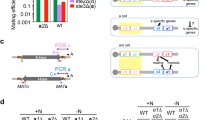Abstract.
Mating-type genes control sexual development in ascomycetes. Little is known about their function in homothallic species, which are self-fertile and do not require a mating partner for sexual reproduction. The function of mating-type genes in the homothallic fungus Sordaria macrospora was assayed using a yeast system in order to find properties typical of eukaryotic transcription factors. We were able to demonstrate that the mating-type proteins SMTA-1 and SMTa-1 have domains capable of activating transcription of yeast reporter genes. Two-hybrid analysis for heterodimerization and homodimerization revealed the ability of SMTA-1 to interact with SMTa-1 and vice versa. These two proteins are encoded by different mating types in the related heterothallic species Neurospora crassa. The interaction between SMTA-1 and SMTa-1 was defined by experiments with truncated versions of SMTA-1 and in vitro by means of protein cross-linking. Moreover, we gained evidence for homodimerization of SMTA-1. Possible functions of mating-type proteins in the homothallic ascomycete S. macrospora are discussed.
Similar content being viewed by others
Author information
Authors and Affiliations
Additional information
Electronic Publication
Rights and permissions
About this article
Cite this article
Jacobsen, S., Wittig, M. & Pöggeler, S. Interaction between mating-type proteins from the homothallic fungus Sordaria macrospora. Curr Genet 41, 150–158 (2002). https://doi.org/10.1007/s00294-002-0276-0
Received:
Accepted:
Issue Date:
DOI: https://doi.org/10.1007/s00294-002-0276-0




